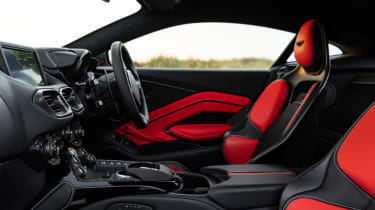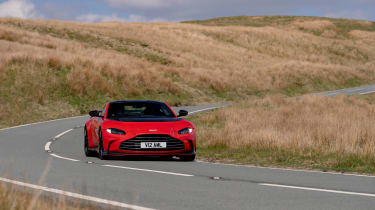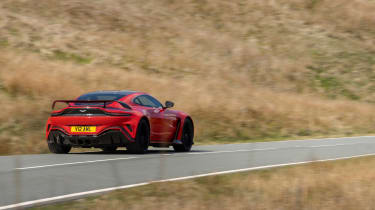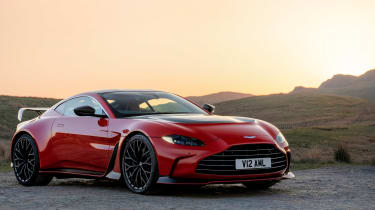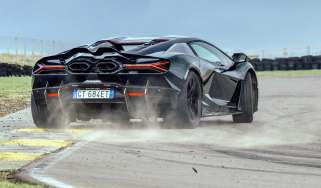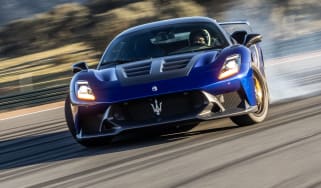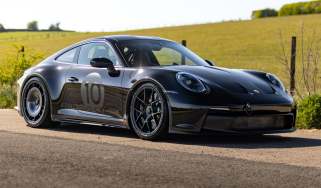Aston Martin V12 Vantage (2022 - 2023) review – why it fails as a fitting sign-off for the Aston V12
It was always going to be a tough job to sign off Aston’s V12, but this is not the finest V12 Vantage, not by a long chalk
There is an inevitable sense of finality about this latest and very last Aston Martin V12 Vantage. In everything it does, in everything it stands for, it represents the end of a once-magnificent era. And on paper, at least, it would appear to live up to such billing.
For starters, it’s propelled by the same monstrous twin turbocharged 5.2-litre V12 that powers the DBS, although in this case its outputs have had to be knocked back a touch because the bigger gearbox simply doesn’t fit within the Vantage’s tighter proportions. Instead, the V12 uses the same 8-speed ZF from the V8, which can’t handle much more torque than it already has to in that car. Even so, there’s still 690bhp at 6500rpm and 555lb ft at 5000rpm, and the kerb weight has been shaved to “just” 1795kg.
Performance? Naturally it’s also big, zero to 62mph taking a claimed 3.5sec with zero to 100mph coming up in less than seven seconds, and a top speed of exactly 200mph. But to be honest, for the money, it’s no rule-breaker in a straight line. Competitive, yes, but no more.
> Aston Martin DB11 review – traditional GT with traditional appeal
But that’s fine, says Aston Martin, because the Vantage V12 isn’t primarily concerned with rewriting the rules on pure performance anyway. It’s more about the way it makes you feel, the sounds it makes, the emotions it ignites – the things it makes you remember, long after you’ve climbed out and walked away etcetera. Hence the reason why the claims surrounding the upgrades to the chassis, steering, brakes and aerodynamics are all somewhat louder and more ambitious than the ones about raw performance.
In all these areas, the Vantage V12 sets pioneering standards for an Aston Martin, claim its creators. In fundamental terms it’s stiffer than any other Vantage by some margin, thanks to strut braces that have been added both front and rear. At the same time it’s also much more stiffly suspended, with 50 per cent increases in spring and anti-roll bar rates at the back and only slightly smaller increases at the front. Its dampers have also been recalibrated to match, which has the knock-on effect of making the steering beefier in feel and response, despite there being no specific alterations to the rack or its weighting.
At each corner sits a monumental carbon ceramic brake disc, and the wheels are suitably vast 21-inch cast (not forged) alloys all round, although interestingly Aston chose not to fit Cup 2s, but instead went for Pilot Sport 4S tyres, which would suggest that this car is intended to be rather more than just a road legal track monster – despite the big carbonfibre wing at the back and the wincingly low and expensive looking carbon skirts and front splitter.
Inside, there isn’t a whole lot to distinguish the V12 from its lesser V8 siblings, except for one thing (or specifically two things): its seats. The car we drove had optional new carbonfibre buckets fitted, which together shave just under 8kg from the kerb weight. But the support they offer appears to be in all the wrong places on the track, and we found them curiously uncomfortable to sit in for anything more than half an hour on the road. They also make the simple business of getting in and out way more of a palaver than it should be in a road car.
On the road the V12 Vantage should be a monumentally lovely car to drive. Its lineage alone means it has an awful lot to live up to. Before I drove it, I thought I was going to love this car.
But sadly no. From pretty much the moment I started driving it, any such grandiose thoughts about it being a heroic final representation of the V12 Vantage quickly evaporated and were replaced by a series of questions. Such as: why is this car so damn stiff? Why doesn’t it breathe properly with the road below in the way that most other Astons have for so many years? Why doesn’t it feel stronger in the low and mid-ranges? Why doesn’t it sound more dramatic? Why is there so much tyre noise? Why is the gearbox so slow-witted compared with rivals from Porsche, Ferrari and Lamborghini, to name but three? And who exactly has this car been engineered to appeal to, given that it appears to be neither one thing nor the other – by which I mean it’s not a proper GT car on the one hand because it’s way too firm and noisy, nor a full-blown track weapon because it’s not focused enough to be one of those either?
Baffled? So was I. So I did a load of miles in it, but the painful truth is, the further I drove it, the less convinced by the V12 Vantage I became. Its ride is crazy stiff for the road in any of the chassis’ three settings, and its steering is strangely lifeless, even though it’s accurate enough in extremis. The sound from the V12 is also oddly distant, even in Track mode, and although it goes hard if you rev the bejesus out of it, in the mid-range there’s a peculiar absence of any genuine gusto. Dialling back the torque to not blow the gearbox to pieces has clearly robbed the V12 of its mid-range thunder, to a point where subjectively I’m not sure it feels as strong as the V8-powered F1 Edition between 3000-5500rpm.
The brakes, on the other hand, are excellent, and the harder you use them, the better they feel. The whole front end, in fact, does begin to come alive the harder you work it. So long as you can summon the strength and courage to hang on tight while doing so. You can aim its nose at most corners at fairly crazed speeds, with a decent degree of confidence that it WILL stick, and that you won’t just end up understeering straight off the road. The tail meanwhile also tends to do what it’s told most of the time, mainly because there’s less torque to unsettle it than you might imagine, but also because the ESP system has been extremely well calibrated. It allows a fair bit of slip before it gently shuts the throttle down, but it never cuts it completely. Which means you can drive the V12 a lot harder than you’d think, without it feeling like you are anywhere near the edge. Even on damp roads, which is saying something.
It’s significantly sharper than any other Vantage in this respect, and it warrants a degree of admiration purely because of this. But even when you’re going for it over a truly great road, it still feels quite ham-fisted in its overall demeanour somehow. It’s quick, yes, and it has a tonne of grip to call upon. Yet all it does ultimately is bully a road into submission through a somewhat uncouth combination of grip and absence of roll. Rarely do you feel emotionally connected to the road below when driving the new V12 Vantage, not even at nine and a half tenths. Or at least I didn’t, which is quite some realisation to become aware of after several hundred miles of trying to find a connection.
It feels like something went oddly wrong with this car to be honest, not when they were designing it because it looks beautiful, but when it was being engineered. It feels like there might well have been disagreements behind the scenes that never got resolved, and that the car itself is the unfortunate manifestation of such unease. Whatever the truth of it, this is not one of Aston Martin’s finest cars – which is nothing less than a tragedy, all things considered.
Price and rivals
Officially the price starts at £265,000, although don’t get too excited about that because all 333 examples have already sold out, most of them costing a good deal more than that once optional items such as carbon packs and lightweight bucket seats have been added. Either way, it’s deep into Ferrari 812 Superfast territory financially.
